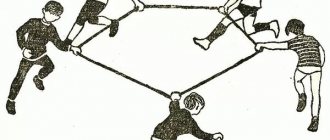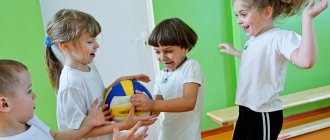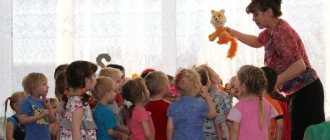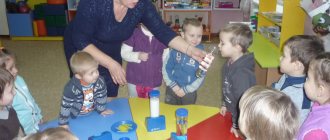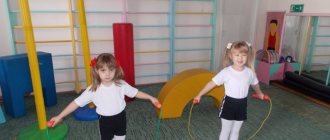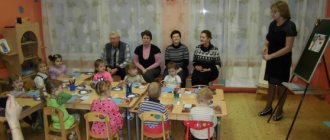Card file of outdoor games and game exercises for the second junior group
| ACTIVE GAMES AND GAME EXERCISES FOR CHILDREN OF edited by N.E. Veraksy, T.S. Komarova, M.A. Vasilyeva) |
| RUN TO ME (II junior group) Tasks: Teach children to act on cues. Practice walking and running in a straight direction. Description: Children sit on chairs placed against one of the walls of the room. The teacher moves to the opposite wall and says “run to me!” Children run to the teacher. The teacher greets them warmly. Then he goes to the other side of the site and says “run to me!” To the teacher’s words “Run home!” children sit on chairs and relax. Rules: run to the teacher only after the words “Run to me!” Children run to the chairs and sit down only after the words “Run home!” Options: At first, children can occupy any chair and then find their own place. Bring in the bell. Call, signal “Run!” |
| BIRDS AND CHICKS (II junior group) Tasks: To develop in children the ability to perform movements at the teacher’s signal, remember their place, and practice running in different directions without touching each other. Description: Children are divided into 3-4 groups of 5-6 people, each group has its own house - a nest. Children pretend to be chicks. Each group has a mother bird. According to the teacher’s words “Let’s fly!” - the chicks fly out of the nest. They fly around the house, waving their arms - their wings. Mother birds fly away to get food. According to the teacher’s words “Home!” - Mother birds return and call their chicks home. In the nest, the chicks sit in a circle and the mother bird feeds them imaginary worms. Rules: Birds and chicks fly out at the teacher’s word “Let’s fly!” The chicks return home at the call of the mother bird. Mother birds return home at the teacher’s word “Home!” Options: Invite the birds to fly to higher ground. Each bird has its own color of the house - nest. You can change houses. |
| MICE AND CAT(IIjunior group) Tasks: To develop in children the ability to perform movements on a signal. Practice running in different directions. Description: Children - “mice” sit in holes (on chairs along the wall). In one of the corners of the playground sits a “cat” - a teacher. The cat falls asleep and the mice scatter around the room. The cat wakes up, meows, and begins to catch mice, which run into their holes and take their places. When all the mice return to their holes, the cat walks through the hall again, then returns to its place and falls asleep. Rules: The teacher makes sure that all the children run out of their holes. The teacher can use a cat toy in the game. Options: Mice jump over a stream, overcome obstacles, and walk along a bridge. Artistic word: The cat didn’t find any mice and went to his room to sleep, As soon as the cat falls asleep, all the mice run out! |
| RUN TO THE FLAG (II junior group) Tasks: To develop children's attention and ability to distinguish colors. Learn to act on a visual signal. Practice running and walking. Description: Children receive flags of two colors - some red, others blue. The teacher stands on one side of the playground and holds a blue flag in one hand and a red flag in the other. Children with blue flags are grouped near blue, with red ones - near red. Then the teacher invites the children to take a walk. Children walk and run around the playground. The teacher goes to the other side and says: “One, two, three - run here quickly!” He stretches his arms to the sides, the children run to the teacher and group themselves near the flag of the corresponding color. When all the children have gathered, he suggests waving the flags. Rules:
Options : Take a ribbon or handkerchief instead of a flag, then dance with it. Enter 2 red and blue flags. The teacher can change the flags by moving them from one hand to the other. Turn on the additional signal “Stop!” (everyone closes their eyes). |
| FIND YOUR COLOR (II junior group) Tasks: To develop children's attention, the ability to distinguish colors, and act on a signal. Exercise in running, walking. Description: Children receive flags of 3-4 colors and are grouped in groups of 4-6 people in different corners of the room, in each corner the teacher places a colored flag on a stand. At the teacher’s signal “Go for a walk!” the children disperse around the playground. To the words “Find your color!” - children gather near the flag of the corresponding color. The teacher notes which group gathered faster. Rules:
Options : Offer to close your eyes and rearrange the flags in the corners of the room. |
| "TRAM" (IIjunior group) Tasks: To develop in children the ability to distinguish the colors of a traffic light and act on a visual signal. Practice running and walking in a column. Familiarize yourself with traffic rules. Description: Children stand along the wall in a column in pairs, holding each other's hands, with their free hands holding on to the cord, the ends of which are tied. The teacher is in one of the corners of the room, holding three colored flags (red, yellow, green). Raises the green flag - the children run (the trolleybus moves). Having reached the teacher, the children look to see if the color of the flag has changed. If it’s green, the movement continues, yellow or red, the children stop and wait for green to appear. Rules:
Options : Arrange a stop where children sit and wait for the trolleybus to arrive. When the trolleybus approaches a stop, it slows down, some passengers get off, others get on. |
| "TRAIN" (IIjunior group) Tasks: To develop in children the ability to perform movements according to a sound signal, to consolidate the skill of forming a column. Practice walking and running after each other. Description: Children line up in a column along one side of the playground. The first is a steam locomotive, the rest are carriages. The teacher blows the whistle, the children begin to move forward (without clutch). First slowly, then faster, gradually starting to run, saying “Choo-chu-chu!” “The train is approaching the station,” says the teacher. Children gradually slow down and stop. The teacher blows the whistle again, and train movement resumes. Rules: You can move only after the beep, i.e. at the teacher's signal. Options : Enter a stop. Children run out into the clearing. They collect “mushrooms and berries” and dance. |
| SHAGY DOG (II junior group) Tasks: Teach children to listen to the text and quickly respond to the signal. Description: The child pretends to be a dog, he sits on a chair at one end of the area, and pretends to be sleeping. The rest of the children are at the other end of the room beyond the line - this is the house. They quietly approach the dog, the teacher says: “Here lies a shaggy dog, with his nose buried in his paws. Quietly, quietly, he lies - either dozing or sleeping. Let’s go up to him, wake him up, and see what will happen?” The dog wakes up, gets up and starts barking. The children run into the house (stand over the line). The role is transferred to another child. The game repeats itself. Options : Put a barrier - benches in the way of children; in the way of the dog. |
| "BIRDS IN NESTS" (IIjunior group) Tasks:
Description. On one side of the playground, hoops (“nests”) are laid out freely according to the number of children. Each child (“bird”) stands in his own “nest”. At the teacher’s signal, the children - “birds” run out of the hoops - “nests” - and scatter throughout the entire playground. The teacher imitates feeding the “birds” at one or the other end of the playground: the children squat down, hitting their knees with their fingertips - they “peck” at the food. “The birds have flown to their nests!” - says the teacher, the children run to the hoops and stand in any free hoop. The game repeats itself. Rules: do not push, help each other get into the hoop, use the entire area allocated for the game lay out 3-4 large hoops - “several birds live in the nest.” At the signal: “The birds have flown to their nests,” the children run, 2-3 children stand in each hoop. |
| «ON THE FLAT PATH» (IIjunior group) Tasks: To develop in children the ability to move rhythmically, coordinate movements with words, and find their place. Practice walking, jumping, squatting, running. Description: The children sit on chairs, the teacher invites them to go for a walk. They get up, group freely or form a column. The teacher says “along the level path, our feet walk, one-two, one-two, over pebbles, over pebbles, into a hole - bang.” When the words “On a level path...” are said, the children walk at a pace. “On the pebbles” they jump on two legs, moving slightly forward. “Thump into the pit” - they squat down. They got out of the hole and the children got up. After 2-3 repetitions, the teacher says “our legs are tired along the level path, this is our home - that’s where we live.” Rules:
Options : Walk along the benches placed along the wall. Jumping into the depths onto a soft path. |
| «CATCH A MOSQUITO» (IIjunior group) Tasks: Develop in children the ability to coordinate movements with a visual signal, exercise children in jumping (bouncing on the spot). Description: The players stand in a circle, at arm's length, facing the center. The teacher is in the middle of the circle. He holds in his hands a rod 1-1.2 meters long with a cardboard mosquito tied to a cord. The length of the cord is 50 cm. The teacher circles the rod and “circles the mosquito”, slightly higher than the heads of the players. When a mosquito flies overhead, the child jumps, trying to catch it. The one who grabs the mosquito says “I caught it!” Then the teacher draws a circle with the rod again. Rules:
Options : You can run ahead, holding a rod with a mosquito in your hands, the children run to catch up with it. |
| «SPARROWS AND CAT» (IIjunior group) Tasks: To develop in children the ability to fit in space and move in a group without touching each other. Act on a signal, practice deep jumps, standing long jumps, and fast running. Description: Children along the walls: on benches, on large cubes or in hoops. These are sparrows on the roof or in nests. A cat, the teacher, sits at a distance. “The sparrows have flown!” - says the teacher. Sparrows jump from the roof, spreading their wings - arms to the sides. They run scattered all over the room. "The cat is sleeping." He wakes up, says “meow - meow!”, runs to catch up with the sparrows, who are hiding, taking their places. The cat takes the caught sparrows to her house. Rules:
Options : Bring in a second cat. Sparrows peck the grains. |
| «HEAN AND CHICKENS» (IIjunior group) Tasks: To develop in children the ability to perform movements on a signal, to practice running in different directions and crawling. Description: Children pretend to be chickens, and the teacher pretends to be a hen. On one side of the site there is a fenced area - a house where the chickens and the hen are located (a rope is stretched between the posts at a height of 50 cm from the floor). A “big bird” is placed on the side, to the side. The hen crawls under the rope and goes in search of food. She calls the chickens - “ko-ko-ko”. At the signal, all the chickens crawl under the rope, run to the hen and walk with her around the floor. The teacher says “big bird”, all the chickens run home. Rules:
Options : Chickens climb onto a perch - a bench, 2 cords are pulled at a distance from each other, the role of the hen is entrusted to the children themselves. |
| «MICE IN THE PANTRY» (IIjunior group) Tasks: To develop in children the ability to perform movements on cue. Practice climbing and running. Description: Children - mice sit in holes, on benches. On the opposite side of the platform there is a rope stretched at a height of 50 cm. This is a storage room. A cat, the teacher, sits to the side of the players. The cat falls asleep, the mice run into the pantry. Penetrating into it, they bend down so as not to touch the rope. There they sit down and seem to be gnawing on crackers or other foods. The cat wakes up, meows and runs after the mice. The mice run into their holes. Returning to the place, the cat falls asleep and the game resumes. Rules:
Options : The mice crawl under the arc, running into the holes, and a second cat is introduced. |
| «RABBIT» (IIjunior group) Tasks: To develop in children the ability to move in a team, to find their place on the playground. Practice crawling, running, and jumping on 2 legs. Description: On one side of the site, circles are drawn - rabbit cages. Chairs are placed in front of them, hoops are tied vertically to them or a cord is stretched. A chair is placed on the opposite side - the watchman's house. Between the house and the rabbit cages is a meadow. The teacher divides the children into small groups of 3-4 people. Each group stands in a circle. “The rabbits are in cages!” - says the teacher. Children squat down - these are rabbits in cages. The teacher approaches the cages one by one and releases the rabbits onto the grass. The rabbits crawl through the hoop and begin to run and jump. The teacher says “Run to the cages!” The rabbits run home and return to their cage, crawling through the hoop again. Then the guard lets them out again. Rules: The rabbits do not run out until the guard opens the cages. The rabbits return after the teacher’s signal “Get into the cages quickly!” Options : Place a bench or chair in each cage according to the number of rabbits. |
| "FIND, WHAT IS HIDDEN?»(IIjunior group) Tasks: Develop children's visual memory and attention. Description: Children sit on chairs, on the floor, in one line. The teacher places three to five objects in the center of the circle and asks them to remember them. Then the players stand up and turn their backs to the center or to the wall and close their eyes. The teacher hides one object lying in the center of the circle and says “Look.” Children open their eyes, turn to face the cent and remember which object is missing. The teacher approaches the children and each of them tells him in his ear what is hidden. When the majority of players give the correct answer, the teacher loudly names the hidden object. After this, the game resumes. Rules:
Options : Consolidate knowledge of primary colors, take cubes or flags. Call one player. Remove 2 items at a time. |
| «GUESS WHO AND WHERESCREAMS»(IIjunior group) Tasks: To develop observation, attention, and activity in children. Description: Children sit in a semicircle on chairs; a screen is placed in front of them at a distance of several steps. The teacher calls someone by name, and he goes behind the screen to agree on what animal or bird the child will portray. Behind the screen you can hear the mooing of a cow, the barking of a dog, etc. The teacher invites one of the children to guess who is screaming. Rules: Only the child pointed out by the teacher can guess the animals or birds. Artistic word: This is such a beautiful house. Who lives in the house? Knock-knock, who lives in the house? Options : Enable recording of animal voices. |
| «BIRDS AND CAT» (IIjunior group) Tasks: Develop determination in children by practicing running and dodging. Description: A circle is drawn on the ground (diameter - 7 m) or a cord is placed, the ends of which are tied. The teacher chooses one player to stand in the center of the circle. It's a cat. The rest of the children, the birds, are outside the circle. The cat is sleeping. Birds fly into a circle for grains. The cat wakes up, sees the birds and catches them. All the birds are in a hurry to fly out of the circle, the one who was touched by the cat while he was in the circle is considered caught and goes to the middle of the circle. When the cat catches 2-3 birds, the teacher chooses a new cat. The previously caught birds join the players. Rules:
Options : Birds fly onto the gymnastics wall; the second cat is introduced, the cat crawls under the collar, arch. |
| «BUBBLE» (IIjunior group) Tasks: To develop in children the ability to coordinate movements with words, to move rhythmically. Exercise children in squatting and forming in a circle, in running in different directions. Description: Children stand close together in a circle, holding hands. Together with the teacher they say: “Blow up your bubble! Blow up big! Stay like this and don’t burst.” By reciting poems, children gradually expand the circle. When the teacher says, “The bubble has burst,” all the children lower their hands and say in unison, “Pop!” and squat down. The teacher offers to inflate a new bubble: the children stand up, form a small circle again, and the game resumes. Rules: Say in unison “Clap!” and squat down only after the words “The bubble burst.” Options : Perform swinging movements with your arms, first a small ball, then a large one - wide swings of your arms. After the words “Don’t burst!” the teacher says “The bubbles are flying!”, the children run away wherever they want. |
| «BUNNY» (IIjunior group) Tasks: To develop in children the ability to coordinate movement with words. Practice running. In hopping on two legs, finding your place. Promote speech development. Description: On one side of the site the places of the hares are marked. Everyone falls into place. At the teacher’s signal “Run in a circle!” all the children gather in a circle, and one of the hares, whom the teacher appoints, stands in the middle. Children with a teacher recite poems and perform movements to the text: The little white bunny sits and wiggles his ears - the children stand in a circle, That's it, that's how he moves his ears! – move their hands, raising them to the head. It's cold for the bunny to sit, we need to warm his little paws, Clap-clap, clap-clap, you need to warm your little paws - they clap their hands. It's cold for the bunny to stand, the bunny needs to jump Skok-skok, skok-skok, the bunny needs to jump - they jump on two legs in place. Someone scared the bunny, the bunny jumped and galloped away! – the teacher claps his hands, the children run away to their homes. Rules:
Options : Place a cord with tied ends on the floor. At the signal they jump over the cord. You can put several birds with one stone in the middle. |
| Task: teach children to jump from circle to circle Description: two lines are drawn on the ground - two banks, between which there is a swamp (the distance between the lines is 30 m). The players are distributed in pairs on one bank and the other. The teacher draws hummocks in the “swamp” - circles (you can use flat hoops) at different distances from each other: 30-80 cm. At a signal, two children jump from hummock to hummock, trying to get to the shore. The one who stumbles remains in the swamp. The next couple comes out. When everyone has completed the task, the teacher nominates who will lead the children out of the swamp. He gives the stuck hand and shows with jumps the way out of the swamp. Rules: you can jump by pushing one or two legs, choosing a route as desired; You can’t put your foot between the bumps; the one who violated remains in the swamp until he is rescued; You can help out after everyone has crossed to the shore. |
| «WHO WILL THROW THE BAG FURTHER» (IIjunior group) Tasks: Develop in children the ability to act on a signal. Practice throwing far away with your right and left hands, running, and recognizing colors. Description: Children stand along the wall. Several children, named by the teacher, stand on the same line in front of a rope placed on the floor. Children receive bags of 3 different colors. According to the teacher’s words “Drop it!” children throw the bag into the distance. The teacher draws the children’s attention to whose bag fell further and says: “Pick up the bags!” Children run for their bags, pick them up and sit down. The teacher names other children who take the places of those who threw the bags. The game ends when all the children have thrown their bags. Rules:
Options : Set guidelines - who is next. Throw cones, balls, spears. |
| "HIT IN A CIRCLE»(IIjunior group) Tasks: Develop in children the ability to act on a signal. Practice throwing with your right and left hands. Description: Children stand in a circle. In the center of the circle there is a circle made of rope, the ends of the rope are tied, the circle can be drawn. The diameter of the circle is 2 meters. Children are 1-2 steps away from the circle. There are bags of sand in their hands. According to the teacher’s word “Throw it!”, everyone throws their bags into the circle. “Pick up the bags!” - says the teacher. Children pick up the bags and stand in place. The teacher notes whose bag did not fall into the circle, the game continues. Children throw with the other hand. Rules:
Options : Instead of bags, throw cones; divide the children into subgroups, each throwing them into their own circle; increase the distance. |
| "KNOCK THE PIN" (IIjunior group) Tasks: develop basic skills of hitting the ball with a target, the ability to energetically push the ball in a given direction, and develop gaze fixation. Description: The teacher (adult) places two or three pins at a distance of 1-1.5 m from the child and gives him a large ball. The child squats, bends over, places his feet slightly wider than shoulder-width apart in the place designated by the adult (colored circle or cord), rolls the ball forward with both hands, trying to knock down the pins. Then he goes after him, picks him up and returns. The teacher (adult) accompanies his demonstration with the following words: Rules: push the ball energetically with both hands, look forward at the pins. |
| "TAKE CARE OF THE OBJECT" (IIjunior group) Task: teach children to act on cues; develop dexterity, endurance, eye. Description: children stand in a circle. Each child has a cube (or rattle) at his feet. The teacher is in a circle, he tries to take an object from one child or another. The player who is approached by the teacher crouches down, covers the cube with his hands and does not allow anyone to touch it. As soon as the teacher leaves, the baby gets up, leaving the cube in the same place. I won't give up my cube! Instructions for carrying out . At first, the teacher does not take the blocks from the children, but only pretends that he will take them now. Then, when repeating the game, he can take the cube from the child who did not have time to close it. This child is temporarily not participating in the game. When the driver manages to take the cubes from two or three players, he returns them to them and tells them to quickly close the cube and not give it back. In the second younger group, you can choose one of the children to play the role of driver. |
“FIND YOUR PLACE” ( II junior group)
Tasks:
develop attention and activity in children. Develop the ability to follow basic rules, coordinate movements, and navigate in space.
Description:
Each player chooses a house for himself: a chair, a circle, a gymnastic bench, etc. At the teacher’s signal, the children run out onto the playground, easily and, trying not to make noise, run in different directions. At the signal “Find your place” they return to their places.
Options
:
1. Children imitate movements: in winter we go skiing (walking with a long stride with a go-ahead), ice skating (walking with the legs out to the side, the torso is tilted, hands behind the back), we make snowballs and throw them (“they took the snow” - tilt, we touched the floor with both hands, “made a snowball”, “threw” - throwing), warming up (running); in the summer we swim (running with arm movements - “breaststroke”), dive (running with stopping and squatting), run after dragonflies and butterflies, and ride a bicycle.
2. Children can be divided into two teams. Children, accompanied by music (tambourine), walk as usual and run around the whole hall in all directions. When the music stops, the children must find their place in the column.
TABLE OF CONTENTS
with running:
- Run to me
- "Birds and Chicks"
- "Mice and Cat"
- "Run to the flag"
- "Find your color"
- "Tram"
- "Train"
- "Shaggy Dog"
- "Birds in Nests"
- "Birds and Cat"
With crawling and climbing:
- "The Mother Hen and the Chicks"
- "Mice in the Pantry"
- "Rabbits"
With jumping:
:
- "On a smooth path"
- "Catch a mosquito"
- "Sparrows and the cat"
- "From bump to bump"
- "Bunny"
With throwing and catching:
- “Who will throw the bag further?”
- "Get in the circle"
- "Knock down the pin"
- "Take care of the object"
For orientation in space:
- “Guess who is screaming and where?”
- "Find your place"
- "Find what's hidden"
- "Bubble"
Outdoor game "Train".
Goal: to train children to walk, run in a column one at a time with changing tempo, act on a signal, find their place in the column.
Progress of the game: Children line up in a column one at a time (without holding each other). The first one is a steam locomotive, the rest are carriages. The teacher blows the whistle and the train begins to move forward, slowly at first, then faster, faster, and finally the children start running. “The train is approaching the station,” says the teacher. The children gradually slow down and the train stops. Children go out for a walk: they disperse across the clearing, picking flowers, berries, mushrooms, and pine cones. Hearing the whistle, they again gather in a column, and the movement of the train resumes. ...At first, children line up in a column in any order, and by the end of the year they get used to remembering their place in the column - finding their car. You can change the plot of the game, for example, the train can stop at a river, then the children pretend to be boating, fishing, etc.
T.I.Osokina “Physical education in kindergarten” (second junior group)
Outdoor game “Tram (trolleybus, bus).”
Goal: to train children to walk, run in a column of two, act in accordance with the color signal, and crawl together.
Progress of the game:
Children stand in a column in pairs, holding each other's hands. With their free hands they hold on to the cord, the ends of which are tied, that is, some children hold on to the cord with their right hand, others with their left. This is a tram. The teacher stands in one of the corners of the room, holding three colored flags in his hands: yellow, red, green. He explains that when the signal is green you have to move, when the signal is red or yellow you have to stop. The teacher raises the green flag - the tram is moving, the children are running around the room (playground). Having reached the teacher (traffic light), the children look to see if the color has changed. If the color is still green, then the tram continues to move; if a red or yellow flag is raised, the children stop and wait for the green flag to appear so that they can move again.
If there are a small number of children, you can put them in one column. You can arrange a stop along the way. Approaching it, the tram slows down and stops. To enter and exit, children lift the cord.
T.I.Osokina “Physical education in kindergarten” (second junior group)
Outdoor game “Mice and cat”.
Purpose: to train children to act in accordance with the rules of the game, to walk, run in all directions, to use the entire area of the hall
Progress of the game: The mouse children sit in holes (on benches or chairs placed along the walls of the hall). A teacher cat sits in one of the corners of the playground. The cat falls asleep and the mice scatter around the room. But then the cat wakes up, stretches, meows and starts catching mice. The mice quickly run and hide in holes (take their places on chairs). After all the mice have returned to their holes, the cat walks around the room again, then returns to its place and falls asleep. ...
Mice can run out of the holes only when the cat closes its eyes and falls asleep, and return to the holes after the cat wakes up and meows. You can also use a toy cat in the game.
T.I.Osokina “Physical education in kindergarten” (second junior group)
